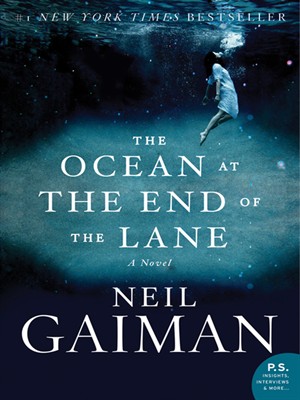
I need to begin this review with an apology to high school English teachers everywhere – especially the ones I had. I confess and apologize for having hated having to analyze all the symbolism, types and anti-types, foreshadowing and the like in what we read. I wondered, perhaps rightly, why an author couldn’t pen a good story to be just that. A good story.
So, to humor them, I would make up the most outlandish interpretations of symbolism in the books we were reading, only to have other students act like my ideas were interesting, brilliant, and likely meanings the author intended. I apologize.
Enter today’s book, “Ocean at the End of the Lane” by Neil Gaiman. Perhaps Gaiman has just written a good story. Perhaps he inserted some symbolism and allegory into this book, a la C.S. Lewis or Tolkien. Either way, I keep seeing things in this book.
“Ocean at the End of the Lane” draws the reader in. It is a story about growing up and beginning to understand grownups. “Grown-ups don’t look like grown-ups on the inside either. Outside, they’re big and thoughtless and they always know what they’re doing. Inside, they look just like they always have. . . . Truth is, there aren’t any grown-ups. Not one, in the whole wide world.”
By the end, however, it becomes a story showing the colossal battle between good and evil, with a trio reminiscent of the Trinity.
The narrator is a 40-something man returning to his childhood home area for a funeral. Killing time between obligations, he ends up wandering to Sussex where he grew up.
Without conscious thought he finds himself at the dilapidated farm house pond (that Lettie, who we will meet later, calls an ocean) at the end of the lane near where his house once stood. He encounters an old woman who invites him in for a cup of tea. Unbidden, the memories begin to return.
The narrator’s family had a boarder, an opal miner, who committed suicide in the family car. This act was “lighting a fuse on a firework” that led to an opening for evil to come into their world.
After an encounter which was too bizarre to share with adults, our narrator found Lettie, an eleven year old girl who may have actually been thousands of years old; her mother, Ginnie Hempstock, and her grandmother, Old Mrs. Hempstock. Each Hempstock seems to be ageless and forever.
The evil that was unleashed into the world revealed itself in Ursula Monkton, a being from another reality who arrived to earth, leaving a wormhole inside the seven year old narrator so she could come and go between realities at will.
Ursula becomes the family’s babysitter and housekeeper, releasing darkness that is unfathomable, un-understandable, and downright terrifying to our narrator.
Lettie Hempstock however, in her magical and mystical way becomes his guardian and protector, occasionally relying on assistance from the older Hempstocks.
In the battle to remove the evil from the world, Lettie makes a supreme sacrifice to protect the narrator and is released into her “ocean” to return again at a time unknown to all.
Throughout the book, I saw pictures of sin, good and evil, pictures of the God-head, redemption and sacrifice. I saw pictures of the transfiguration and the Second Coming. The price Lettie paid to save the nameless boy invokes Biblical themes of sacrifice for salvation.
Gaiman writes a story a hard to summarize because there are so many layers and complexities to it. Not everyone will enjoy it, but I certainly enjoyed the audio version. Gaiman is a skilled narrator which unusual for authors reading their own works. JPL has the book in print and downloadable audio.
Read it, savor it, and look for meaning in this book. Or perhaps, it’s just a good story meant to be only that. A good story. You read it and decide.
